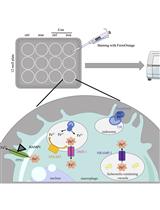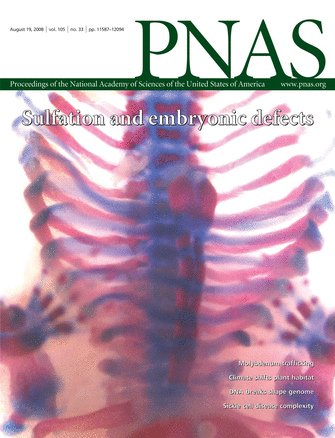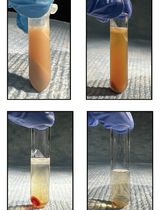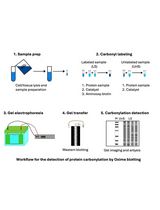- EN - English
- CN - 中文
In-Gel Activity Assay of Mammalian Mitochondrial and Cytosolic Aconitases, Surrogate Markers of Compartment-Specific Oxidative Stress and Iron Status
哺乳动物线粒体和胞质顺乌头酸酶的凝胶内活性测定——分区特异性氧化应激与铁状态的替代标志物
发布: 2024年12月05日第14卷第23期 DOI: 10.21769/BioProtoc.5126 浏览次数: 1970
评审: Elizabeth CalzadaAnonymous reviewer(s)

相关实验方案

在平板检测仪中使用高特异性荧光探针定量巨噬细胞细胞二价铁 (Fe2+) 含量
Philipp Grubwieser [...] Christa Pfeifhofer-Obermair
2024年02月05日 2043 阅读
Abstract
Two aconitase isoforms are present in mammalian cells: the mitochondrial aconitase (ACO2) that catalyzes the reversible isomerization of citrate to isocitrate in the citric acid cycle, and the bifunctional cytosolic enzyme (ACO1), which also plays a role as an RNA-binding protein in the regulation of intracellular iron metabolism. Aconitase activities in the different subcellular compartments can be selectively inactivated by different genetic defects, iron depletion, and oxidative or nitrative stress. Aconitase contains a [4Fe-4S]2+ cluster that is essential for substrate coordination and catalysis. Many Fe-S clusters are sensitive to oxidative stress, nitrative stress, and reduced iron availability, which forms the basis of redox- and iron-mediated regulation of intermediary metabolism via aconitase and other Fe-S cluster-containing metabolic enzymes, such as succinate dehydrogenase. As such, ACO1 and ACO2 activities can serve as compartment-specific surrogate markers of oxygen levels, reactive oxygen species (ROS), reactive nitrogen species (RNS), iron bioavailability, and the status of intermediary and iron metabolism. Here, we provide a protocol describing a non-denaturing polyacrylamide gel electrophoresis (PAGE)-based procedure that has been successfully used to monitor ACO1 and ACO2 aconitase activities simultaneously in human and mouse cells and tissues.
Key features
• Monitoring aconitase activity changes in the mitochondria and cytosol simultaneously in response to oxidative or nitrative stress, iron depletion, and various pathophysiological conditions.
• Optimized for human and mouse cell lines and tissue samples.
• Semi-quantitative detection of aconitase isoforms with different states of phosphorylation and/or post-translational modification.
Keywords: Aconitase (顺乌头酸酶)Background
Aconitases play a central role in the crosstalk between citrate and iron metabolism [1]. Aconitase is best known for its metabolic function in the mitochondrial citric acid cycle, the primary catabolic pathway that reduces NADP+ to generate NADPH that feeds into the oxidative phosphorylation pathway for ATP production. In addition to the mitochondrial isoform ACO2, mammalian cells express various levels of a bifunctional cytosolic ACO1 that can register iron and oxidative stress through its labile Fe–S cluster. Upon the loss of its Fe-S cluster, ACO1 converts to an iron response element (IRE) binding protein IRE-BP1 (also known as iron regulatory protein 1, IRP1), which binds to IRE-containing RNAs and thereby regulates the expression of various proteins that are important in iron metabolism, including iron storage protein ferritin, iron transport proteins (transferrin receptor TfR1 and ferroportin), and erythrocyte-specific heme biosynthesis protein aminolevulinate synthase, among several targets [1]. Thus, the spatial separation of ACO1/IRP1 and ACO2 allows them to serve as indexes of compartment-specific Fe-S cluster biogenesis/repair pathways, oxidative stress, nitrative stress, and iron status.
The UV/vis spectrophotometric coupled enzyme assay that couples the reactions of aconitase and NADP-dependent (IDH) has offered a very sensitive method for detecting and measuring aconitase activities in purified protein or in whole-cell lysates [2]. However, although subcellular fractions can be used for assaying ACO1 and ACO2 separately, the time and laborious procedure needed for obtaining relatively pure subcellular fractions often results in the loss of the Fe-S cluster and diminished enzyme activities. Mitochondrial and cytosolic aconitase activities in whole-Drosophila extracts have also been assayed jointly after electrophoretic separation on cellulose acetate membranes [3]; however, empirical testing showed that the method was not suitable for quantitative analysis of mammalian aconitase activities, given the different pKa values of aconitases in different species. In addition, it is not possible to know the exact amount of protein loaded onto the cellulose acetate membrane, and the signals from mammalian cell line extracts are much weaker compared to those from the whole fly extracts.
The current protocol describes the non-denaturing polyacrylamide gels and buffers for in-gel assay for human or mouse aconitase activities (adapted from previous work [4]). Aconitase activity was detected chromogenically by incubating the gel after electrophoresis in a coupled enzyme assay mix containing cis-aconitate, NADP-dependent isocitrate dehydrogenase, NADP, thiazolyl blue tetrazolium bromide and phenazine methosulfate. Quantification of the activity of each aconitase isoform is carried out by densitometric analysis.
Materials and reagents
Reagents
Dry ice
Triton X-100 (Sigma-Aldrich, catalog number: T-8787)
RIPA extraction buffer (e.g., RIPA Lysis and Extraction Buffer, Thermo Scientific, catalog number: 89900, ts: 25 mM Tris·HCl pH 7.6, 150 mM NaCl, 1% NP-40, 1% sodium deoxycholate, 0.1% SDS)
Potassium chloride (KCl) (Sigma, catalog number: P3911)
Protein assay reagents (e.g., Protein Assay Kit I, Bio-Rad, catalog number: 5000001EDU)
Ethanol (generic)
30% (w/v) acrylamide/methylene bisacrylamide solution (37.5:1 ratio) (e.g., ProtoGel 30%, National diagnostics, catalog number: EC-890)
TEMED (National Diagnostics, catalog number: EC-503)
Ammonium persulfate (National Diagnostics, catalog number: EC-504)
Tris base (e.g., Sigma, catalog number: T1503)
Boric acid (Sigma-Aldrich, catalog number: B0394)
Glycine (Sigma-Aldrich, catalog number: G7126)
Sodium citrate (Sigma-Aldrich, catalog number: S4641)
NADP-dependent IDH (Sigma-Aldrich, catalog number: I-2002)
Cis-aconitic acid (Sigma-Aldrich, catalog number: A-3412)
β-NADP (Sigma-Aldrich, catalog number: N-0505)
Thiazolyl blue tetrazolium bromide (also known as MTT) (Sigma-Aldrich, catalog number: M2128)
Phenazine methosulfate (PMS) (Sigma-Aldrich, catalog number: P-9625)
Magnesium chloride (MgCl2) (Sigma-Aldrich, catalog number: M4880)
Protease inhibitor cocktail (e.g., Roche Complete mini protease inhibitor cocktail tablet, Millipore Sigma, catalog number: 11836153001)
Dithiothreitol (DTT) (e.g., Pierce DTT, No-WeightTM Format Thermo Fisher Scientific, catalog number: A39255)
Glycerol (generic)
Manganese chloride (MnCl2) (Sigma-Aldrich, catalog number: M1787)
Bromophenol blue (Bio-Rad, catalog number: 1610404)
Pre-stained protein standard (e.g., Thermo Fisher SeeBlue Plus2, catalog number: LC5925)
Optional: ACO2 antibody (Proteintech, catalog number: 11134-1-AP)
Optional: Tubulin antibody (Sigma-Aldrich, catalog number: T9026)
Phosphate buffered saline (PBS) (e.g., Corning, catalog number: 46-013-CM)
Isopropyl alcohol (e.g., Sigma-Aldrich, catalog number: I9516)
Stock reagents:
1 M Tris-HCl (adjusted to pH 7.5 and 8.0 with HCl), store at room temperature (RT)
40 mM KCl, 25 mM Tris-Cl, pH 7.5, store at RT
25% Triton, store at RT
1 M sodium citrate (500×), store at -20 °C
20 mM MnCl2, store at -20 °C
20 mM β-NADP (20×), store at -20 °C
50 mM cis-aconitate (20×), store at -20 °C
1 M MgCl2, store at -20 °C
0.5 mg/20 μL PMS, store at -20 °C
10% ammonium persulfate (APS) (prepare fresh)
0.1 M DTT (prepare fresh)
Solutions
1% Triton-citrate extraction buffer (see Recipes)
RIPA-citrate extraction buffer (see Recipes)
Electrophoresis buffers for the human aconitase in-gel activity assay (see Recipes)
10× Tris-glycine-8.3 stock for running buffer
Running buffer: Tris-glycine-citrate-8.3
Gel buffer: Tris-borate-8.3
4× loading buffer
Gel recipes for the human aconitase in-gel activity assay (see Recipes)
Separating gel for human aconitases
Stacking gel for human aconitases
Electrophoresis buffers for the mouse aconitase in-gel activity assay (see Recipes)
10× Tris-glycine-8.7 stock for running buffer
Running buffer: Tris-glycine-citrate-8.7
Gel buffer: Tris-borate-8.7
4× loading buffer
Gel recipes for the mouse aconitase in-gel activity assay (see Recipes)
Separating gel for mouse aconitases
Stacking gel for mouse aconitases
Aconitase activity coupled enzyme assay mix (see Recipes)
Recipes
1% Triton-citrate extraction buffer
Reagent Final concentration Quantity or Volume Buffer (40 mM KCl, 25 mM Tris-Cl, pH 7.5) 9.18 mL Triton 25% 1% 0.40 mL Roche Complete mini protease inhibitor cocktail tablet 1 DTT 0.1 M (made fresh) 1.0 mM 0.10 mL Sodium citrate, 1 M, 500× 2.0 mM 0.020 mL MnCl2, 20 mM 0.60 mM 0.30 mL Total volume 10 mL Notes:
Store the Triton-citrate extraction buffer in 0.5–1 mL aliquots at -20 °C for 3–6 months.
Citrate is added to stabilize the Fe-S cluster in aconitase.
RIPA-citrate extraction buffer
Reagent Final concentration Quantity or Volume RIPA Lysis and Extraction Buffer 9.58 mL Roche Complete mini protease inhibitor cocktail tablet 1 DTT 0.1 M (made fresh) 1.0 mM 0.10 mL Sodium citrate, 1 M, 500× 2.0 mM 0.020 mL MnCl2, 20 mM 0.60 mM 0.30 mL Total volume 10 mL Notes:
Store the RIPA-citrate extraction buffer in 0.5–1 mL aliquots at -20 °C for 3–6 months.
Citrate is added to stabilize the Fe-S cluster in aconitase.
Electrophoresis buffers for the human aconitase in-gel activity assay
10× Tris-glycine-8.3 stock for running buffer
Reagent Final concentration Quantity or Volume Tris base 250 mM 30.2 g Glycine 1.92 M 144 g H2O Enough to make 1 L buffer Total volume 1.0 L Note: Do not adjust the pH of this 10× stock. The pH of this stock will be ~8.3.
Running buffer: Tris-glycine-citrate-8.3
Reagent Final concentration Quantity or Volume 10× Tris-glycine-8.3 stock 1× 80 mL 1 M sodium citrate 3.6 mM 2.88 mL H2O Enough to make 0.8 L buffer Total volume 0.80 L Gel buffer: Tris-borate-8.3
Reagent Final concentration Quantity or Volume Tris base 890 mM 108 g Boric acid 890 mM 55 g H2O Enough to make 1 L buffer Total volume 1.0 L Note: Do not adjust the pH of this stock. The pH of this buffer will be ~8.3.
4× loading buffer
Reagent Final concentration Quantity or Volume 1 M Tris-Cl pH 8.0 100 mM 0.10 mL Glycerol 40% 0.40 mL Bromophenol blue 1 mg 0.1% H2O Enough to make 1 mL buffer Total volume 1.0 mL Gel recipes for the human aconitase in-gel activity assay
For HeLa cell extract, an 8% acrylamide separating gel at pH 8.3 and electrophoresis at 170 V for 2.5 h at 4 °C gives a good resolution of two bands corresponding to ACO1 and ACO2. For better resolution of samples that contain more than two isoforms (e.g., aconitases with different phosphorylation), a 6% or 7% acrylamide separating gel may be used.
Separating gel for human aconitases
8% acrylamide
Tris-borate-citrate-8.3
mini gel
6% acrylamide
Tris-borate-citrate-8.3
mini gel
8% acrylamide
Tris-borate-citrate-8.3
big gel
ProtoGel 30% 1.68 mL 1.26 mL 6.7 mL Tris-borate-8.3 gel buffer 0.94 mL 0.94 mL 3.75 mL H2O 3.64 mL 4.06 mL 14.55 mL Sodium citrate, 1 M 22.5 μL 22.5 μL 90 μL APS 10% 31 μL 31 μL 125 μL TEMED 6.25 μL 6.25 μL 25 μL Stacking gel for human aconitases
4% acrylamide
Tris-borate-citrate-8.3
mini gel
4% acrylamide
Tris-borate-citrate-8.3
big gel
ProtoGel 30% 0.20 mL 0.80 mL Tris-borate-8.3 gel buffer 0.11 mL 0.45 mL H2O 1.16 mL 4.65 mL Sodium citrate, 1 M 4.2 μL 21 μL APS 10% 21 μL 84 μL TEMED 3.75 μL 15 μL Electrophoresis buffers for the mouse aconitase in-gel activity assay
10× Tris-glycine-8.7 stock for running buffer
Reagent Final concentration Quantity or Volume Tris base 250 mM 30.2 g Glycine 960 mM 72 g H2O Enough to make 1 L buffer Total volume 1.0 L Note: Do not adjust the pH of this 10× stock.
Running buffer: Tris-glycine-citrate-8.7
Reagent Final concentration Quantity or Volume 10× Tris-glycine-8.7 stock 1× 80 mL 1 M Sodium citrate 3.6 mM 2.88 mL H2O Enough to make 0.8 L buffer Total volume 0.80 L Gel buffer: Tris-borate-8.7
Reagent Final concentration Quantity or Volume Tris base 890 mM 54 g Boric acid 445 mM 13.75 g H2O Enough to make 0.5 L buffer Total volume 0.50 L Note: Do not adjust the pH of this stock.
4× loading buffer
Reagent Final concentration Quantity or Volume 1 M Tris-Cl pH 8.0 100 mM 0.10 mL Glycerol 40% 0.40 mL Bromophenol blue 1 mg 0.10% H2O Enough to make 1 mL buffer Total volume 1.0 mL Gel recipes for the mouse aconitase in-gel activity assay
For mouse liver samples, a 5%–6% acrylamide Tris-borate-citrate-8.7 separating gel and 4%–5% stacking gel and electrophoresis at 170 V for 3–4 h at 4 °C gives nice resolution and detection of two ACO1 bands and two ACO2 bands.
Separating gel for mouse aconitases
5% acrylamide
Tris-borate-citrate-8.7
mini gel
6% acrylamide
Tris-borate-citrate-8.7
mini gel
ProtoGel 30% 1.1 mL 1.26 mL Tris-borate-8.7 gel buffer 0.94 mL 0.94 mL H2O 4.22 mL 4.06 mL Sodium citrate, 1 M 22.5 μL 22.5 μL APS 10% 31 μL 31 μL TEMED 6.5 μL 6.5 μL Stacking gel for mouse aconitases
4% acrylamide
Tris-borate-citrate-8.7
mini gel
5% acrylamide
Tris-borate-citrate-8.7
mini gel
ProtoGel 30% 0.20 mL 0.25 mL Tris-borate-8.7 buffer 0.11 mL 0.11 mL H2O 1.16 mL 1.11 mL Sodium citrate, 1 M 4.2 μL 4.2 μL APS 10% 21 μL 21 μL TEMED 3.75 μL 3.75 μL Aconitase activity coupled enzyme assay mix
Prepare fresh immediately before use.
Reagent Final concentration Quantity or Volume Tris, 1 M, pH 8.0 100 mM 1.0 mL NADP, 20 mM (20×) 1.0 mM 0.50 mL cis-aconitate 50 mM (20×) 2.5 mM 0.50 mL MgCl2 1 M, (200×) 5.0 mM 0.050 mL MTT, 24 mM (20×) 1.2 mM 0.50 mL PMS (0.5 mg/20 μL) 40 μL IDH 5 U/mL Dependent on specific activity H2O ~7.40 mL Total 10 mL Notes:
Use 10–15 mL for small gels and more for big gels.
MTT is light-sensitive. Prewarm H2O at 37 °C in a light-protected container. Add the remaining reagents, IDH last, right before staining.
Laboratory supplies
Snap-cap or screw-cap microcentrifuge tubes that can be closed tightly (e.g., USA Scientific, catalog number: 1615-5500)
Homogenization beads (e.g., Next Advance ZrOB10 Zirconium Oxide Beads 1.0 mm)
Equipment
Refrigerated microcentrifuge
Homogenizer/cell disruptor (e.g., Next Advance Bullet Blender or mortar and pestle)
Vertical gel electrophoresis system (e.g., Bio-Rad Laboratories, model: Mini-PROTEAN® II)
Mini-gel glass plates (e.g., Gel Company, model: GBS07B-10S or GBS07L-10)
Mini-gel 10-lane or 12-lane 1.0 mm thick comb (Bio-Rad or Gel Company)
Mini-gel 10-lane or 12-lane 1.0 mm thick spacers (Bio-Rad or Gel Company)
pH meter
Scanner
Gel dryer
Software and datasets
Densitometric analysis software, e.g., ImageJ or similar software
Procedure
文章信息
稿件历史记录
提交日期: Jun 20, 2024
接收日期: Sep 25, 2024
在线发布日期: Oct 17, 2024
出版日期: Dec 5, 2024
版权信息
© 2024 The Author(s); This is an open access article under the CC BY-NC license (https://creativecommons.org/licenses/by-nc/4.0/).
如何引用
Tong, W. H. and Rouault, T. A. (2024). In-Gel Activity Assay of Mammalian Mitochondrial and Cytosolic Aconitases, Surrogate Markers of Compartment-Specific Oxidative Stress and Iron Status. Bio-protocol 14(23): e5126. DOI: 10.21769/BioProtoc.5126.
分类
细胞生物学 > 细胞新陈代谢 > 其它化合物
分子生物学 > 蛋白质 > 活性
您对这篇实验方法有问题吗?
在此处发布您的问题,我们将邀请本文作者来回答。同时,我们会将您的问题发布到Bio-protocol Exchange,以便寻求社区成员的帮助。
提问指南
+ 问题描述
写下详细的问题描述,包括所有有助于他人回答您问题的信息(例如实验过程、条件和相关图像等)。
Share
Bluesky
X
Copy link










